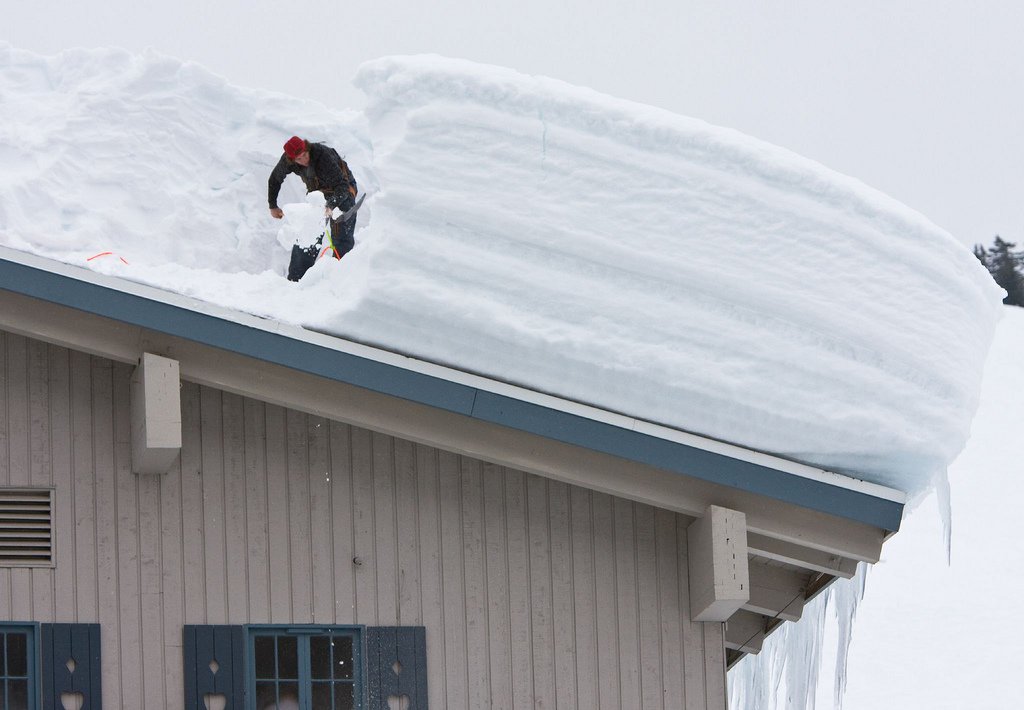
Winter Storms and Your Roof part-2
Snow Removal on Your Roof
SNOW/ICE REMOVAL
Every situation is different so careful planning must be conducted before removal begins.
1. Always provide proper safety precautions when working on the roof, especially along the edge of the roof. Never send one person on a roof to remove snow alone. Place ladders at the end of the building so sliding snow will not dislodge them.
2. Remove drifted areas first, down to the level of the snow on the remaining roof. Next, remove the snow from the middle 1/3 of each bay (form eave to eave), beginning with the most snow packed bay. Complete snow removal on the remainder of the building. On gabled buildings, remove snow on both sides of the ridge at the same time.
3. Remove snow in a pattern that does not cause an unbalanced loading condition. Avoid the large differences in snow depth between adjacent areas of the roof. Remove snow gradually in layers from all over the roof.
4. Remove snow from eave toward ridge, but be cautious of snow or ice breaking away and sliding down the roof. Prior to removing snow from the roof, remove all hanging icicles from eaves and gutters. These can be quite heavy and cause snow/ice to hang up.
5. Do not pile shoveled snow on other areas of the roof or on other roofs. Keep dumping area clear of all persons and property. 6. Always use plastic shovels. Do not use picks, axes or other sharp tools.
7. Do not attempt to remove snow by washing it off with a hose. Snow acts as a sponge and will rapidly absorb water, increasing the loads on the roof and potentially causing failure.
8. Be careful to avoid hitting panel straps, fasteners, snow guards etc. Care must also be taken in removing snow and ice around ventilator bases, pipe flashing, rooftop unit supports, conduits, etc., since such items are easily damaged. 9. Be aware of skylight systems locations. These panels are not intended to support roof foot traffic loads.
DOCUMENTING SNOW LOADS AND RESULTING DAMAGE
General Builders should notify Butler (Regional Engineering Manager, or Area Manager) any time a building suffers any damage or collapse due to excessive snow. Procedure
1. The most important task is to get to the site as quickly as possible to perform a full investigation.
2. Assistance from the Builder is necessary to make arrangements with the customer and accompany the Butler representative to the site. One or two laborers from the Builder’s crew would be very helpful.
3. Equipment required: a. A good camera – quality 35 mm, digital or 2 1/4 x 2 1/4, NOT a Polaroid; b. Color print film; c. 50’ tape; d. Shovels; e. Yardstick (with legible numbers suitable for photographing.) f. A scale and suitable container for weighting snow.
4. Obtain pictures of: a. Building overall views from as many sides as possible; b. General interior views; c. Detail pictures of individual members which might indicate nature of failure; d. Damages to contents or lack of damages; e. Multiple photographs of the snow both on the building and surrounding areas, any drifts and snow sampling procedure.
5. Make notes keyed to the above pictures as to description and location of parts. Sketch building plan showing failure area, collapsed position of main members, etc.
6. Snow Sampling Procedures: a. Obtain representative samples of undisturbed snow on the roof. Take samples as close to the collapse area as is safely possible. Samples from other areas of the roof should also be taken. If the roof is inaccessible, take samples on the ground reasonably close to the building. Use the yardstick and carefully measure a 1 ft. x 1 ft. area and the snow depth. Weigh this block of snow by using the scale and container (do not forget to subtract the weight of the container). Photograph samples and weighing procedures. This procedure must be repeated at several locations on the roof, if possible. b. Make a building plan sketch showing the snow distribution and where the weight sample or samples were taken. Identify snow drift locations and indicate any adjacent roofs or walls that would or did cause dumping or drifting conditions. c. Note snow depth on roofs of buildings in the general area and on the ground in the area of the building.
IN CASE OF COLLAPSE
In case of a roof collapse, mitigation of loss should be the first priority. Damage to contents is a major item and prompt snow removal is imperative. Once the snow is removed, the next step is construction of temporary cover to keep the weather out and allow clean-up to begin. Documenting the snow loads and resulting damage is also essential. For your reference, belowcontains a procedure Lichtefeld and Butler uses in these situation. Your assistance in gathering this information will be most helpful if there is an occurance. Lichtefeld and Butler Manufacturing stands ready to work with you in these situations.
Call Lichtefeld, Inc for assitance as soon as you can 877-589-4777 for profesional help.
